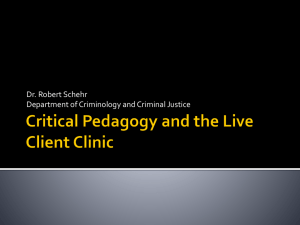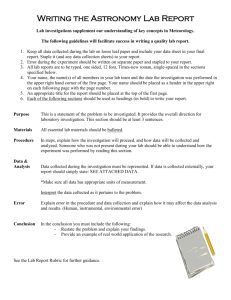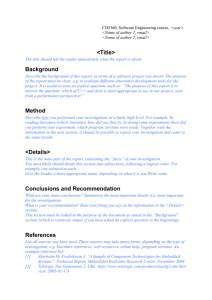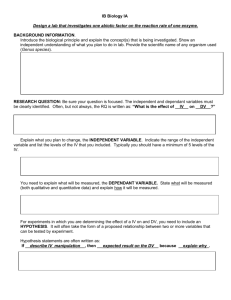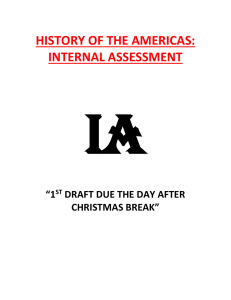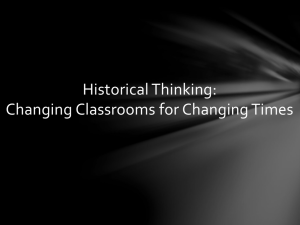Markscheme and Guidance for Students
advertisement
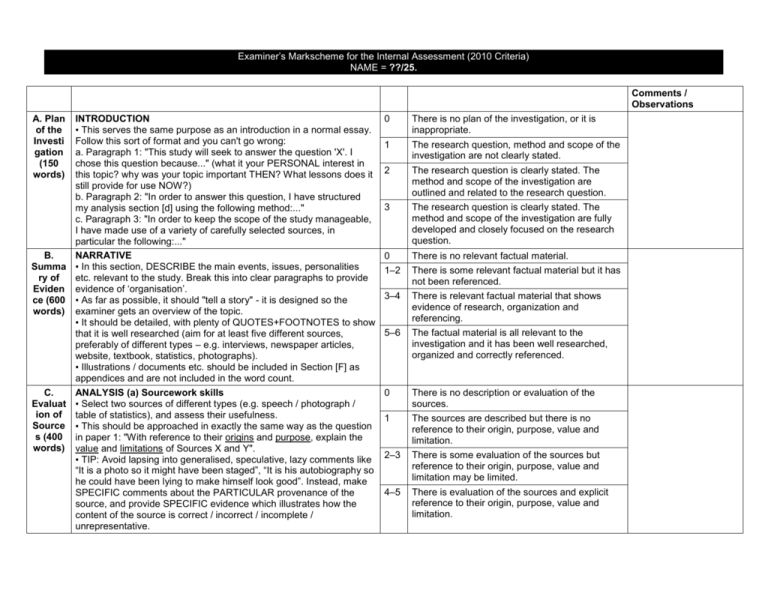
Examiner’s Markscheme for the Internal Assessment (2010 Criteria) NAME = ??/25. Comments / Observations A. Plan of the Investi gation (150 words) INTRODUCTION ▪ This serves the same purpose as an introduction in a normal essay. Follow this sort of format and you can't go wrong: a. Paragraph 1: "This study will seek to answer the question 'X'. I chose this question because..." (what it your PERSONAL interest in this topic? why was your topic important THEN? What lessons does it still provide for use NOW?) b. Paragraph 2: "In order to answer this question, I have structured my analysis section [d] using the following method:..." c. Paragraph 3: "In order to keep the scope of the study manageable, I have made use of a variety of carefully selected sources, in particular the following:..." B. NARRATIVE Summa ▪ In this section, DESCRIBE the main events, issues, personalities ry of etc. relevant to the study. Break this into clear paragraphs to provide Eviden evidence of ‘organisation’. ce (600 ▪ As far as possible, it should "tell a story" - it is designed so the words) examiner gets an overview of the topic. ▪ It should be detailed, with plenty of QUOTES+FOOTNOTES to show that it is well researched (aim for at least five different sources, preferably of different types – e.g. interviews, newspaper articles, website, textbook, statistics, photographs). ▪ Illustrations / documents etc. should be included in Section [F] as appendices and are not included in the word count. C. ANALYSIS (a) Sourcework skills Evaluat ▪ Select two sources of different types (e.g. speech / photograph / ion of table of statistics), and assess their usefulness. Source ▪ This should be approached in exactly the same way as the question s (400 in paper 1: "With reference to their origins and purpose, explain the words) value and limitations of Sources X and Y". ▪ TIP: Avoid lapsing into generalised, speculative, lazy comments like “It is a photo so it might have been staged”, “It is his autobiography so he could have been lying to make himself look good”. Instead, make SPECIFIC comments about the PARTICULAR provenance of the source, and provide SPECIFIC evidence which illustrates how the content of the source is correct / incorrect / incomplete / unrepresentative. 0 There is no plan of the investigation, or it is inappropriate. 1 The research question, method and scope of the investigation are not clearly stated. 2 The research question is clearly stated. The method and scope of the investigation are outlined and related to the research question. 3 The research question is clearly stated. The method and scope of the investigation are fully developed and closely focused on the research question. 0 There is no relevant factual material. 1–2 There is some relevant factual material but it has not been referenced. 3–4 There is relevant factual material that shows evidence of research, organization and referencing. 5–6 The factual material is all relevant to the investigation and it has been well researched, organized and correctly referenced. 0 There is no description or evaluation of the sources. 1 The sources are described but there is no reference to their origin, purpose, value and limitation. 2–3 There is some evaluation of the sources but reference to their origin, purpose, value and limitation may be limited. 4–5 There is evaluation of the sources and explicit reference to their origin, purpose, value and limitation. D. ANALYSIS (b) Essay skills Analysi ▪ This is the main part of the study, and should be written in the same s (650 format as an IB essay. You could follow this format words) 1. Different interpretations: What are the main debates between historians and commentators on your subject? In other words, what are the most obvious points of disagreement between the sources you have used in Sections B and C? (remember quotes and footnotes!) 2. Critical analysis of evidence: In the context of the debates outline above, outline the strengths and limitations of the sources you have used in Sections B and C. Accurately footnote each and every source using the Harvard Author-Date system. Phrases like "...and this witness is particularly reliable because..." and "...although we need to bear in mind that there are limitations to this source because..." are helpful here. 0 There is no analysis. 1–2 There is some attempt at analysing the evidence presented in section B. 3–4 There is analysis of the evidence presented in section B and references are included. There may be some awareness of the significance to the investigation of the sources evaluated in section C. Where appropriate, different interpretations are considered. 5–6 There is critical analysis of the evidence presented in section B, accurate referencing, and an awareness of the significance to the investigation of the sources evaluated in section C. Where appropriate, different interpretations are analysed. E. Conclu sion (200 words) Restate your main findings. Outline why any conclusion remains provisional, e.g. Historiography and philosophy in history: Does the study raise any fundamental problems of history? Refer to your TOK sessions on causation and sources here to help. For example: how films necessarily simplify issues; how biographies are too subjective; how statistics are open to interpretation. 0 There is no conclusion, or the conclusion is not relevant. 1 The conclusion is stated but is not entirely consistent with the evidence presented. 2 F. List of Source s/ Word Limit ▪ A bibliography and / or list of other sources must be included although this will not form part of the word count. ▪ All sources need to be listed. A consistent, recognised system should be used (e.g. the Harvard author-date system) ▪ It is recommended that non-written sources (websites, oral interviews, pictures etc) are listed separately. 0 The conclusion is clearly stated and consistent with the evidence presented. A list of sources is not included or the investigation is not within the word limit. (no word limit to this) 1 A list of sources is included but these are limited or one standard method is not used consistently or the word count is not clearly and accurately stated on the title page. 2 A list of sources using one standard method is included and the investigation is within the word limit. 3 An appropriate list of sources, using one standard method, is included. The investigation is within the word limit.
